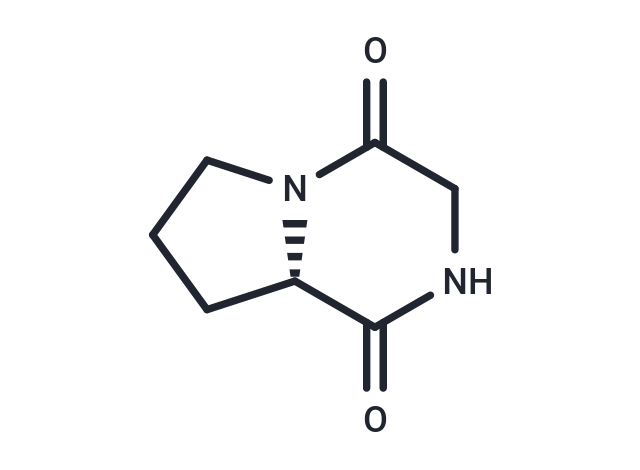Shopping Cart
- Remove All
 Your shopping cart is currently empty
Your shopping cart is currently empty

Cyclo(Gly-(L)-Pro) shows immunostimulatory properties. Cyclo(Gly-l-Pro) exhibits potent inhibition of TNF-α release with the IC50 values of 4.5 ug/mL, respectively, it also exhibits significant diminution of IL-1β and IL-6 mRNA-expression levels and NO production.

| Pack Size | Price | Availability | Quantity |
|---|---|---|---|
| 50 mg | $50 | 7-10 days | |
| 1 mL x 10 mM (in DMSO) | $50 | 7-10 days |
| Description | Cyclo(Gly-(L)-Pro) shows immunostimulatory properties. Cyclo(Gly-l-Pro) exhibits potent inhibition of TNF-α release with the IC50 values of 4.5 ug/mL, respectively, it also exhibits significant diminution of IL-1β and IL-6 mRNA-expression levels and NO pr |
| In vitro | This study was undertaken to isolate active secondary metabolites from immunostimulatory Alcaligenes faecalis FY-3 and evaluate their activities using grass carp Ctenopharyngodon idella kidney (CIK) cells. METHODS AND RESULTS:By applying chromatography techniques and successive recrystallization, three purified metabolites were obtained and identified by spectral data (mass spectrometry and nuclear magnetic resonance) as: (1) phenylacetic acid, (2) p-hydroxyphenylacetylamide and (3) Cyclo(Gly-L-Pro). CIK cells were stimulated by different concentrations (1, 10 and 100 μg/ml) of the isolated compounds, and expression of MyD88, IL-1β, TNF-α, type I-IFN and IL-8 genes at different time points (2, 8 and 24 h) post-stimulation was quantified by real-time PCR. The known immunostimulatory agent lipopolysaccharide (LPS) was used as a positive control. To analyse whether these compounds are toxic to the cells, the methyl tetrazolium assay was employed to measure changes in cell viability. The obtained results revealed that transcribing level of MyD88, an important adaptor molecule in toll-like receptor signalling pathway, was augmented remarkably by all the three isolated compounds and LPS as early as 2-h exposure. These compounds also induced gene expression of cytokines such as IL-1β, TNF-α and type I-IFN. Under the experimental conditions, none of the test compounds is toxic to the CIK cells. CONCLUSIONS:These findings demonstrate that the immunostimulatory properties of the three metabolites [phenylacetic acid, p-hydroxyphenylacetylamide and Cyclo(Gly-L-Pro) ] from A. faecalis FY-3 in CIK cells and highlight the potential of using these metabolites as immunostimulants in fish aquaculture. |
| Molecular Weight | 154.17 |
| Formula | C7H10N2O2 |
| Cas No. | 3705-27-9 |
| Relative Density. | 1.31g/cm3 |
| Storage | Powder: -20°C for 3 years | In solvent: -80°C for 1 year | Shipping with blue ice. |

Copyright © 2015-2025 TargetMol Chemicals Inc. All Rights Reserved.